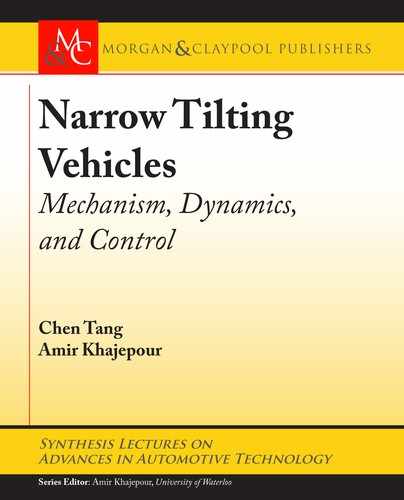2.4. INTEGRATED SUSPENSION TILTING SYSTEM 11
Manufacturing and Operational Costs
e tilting system as an auxiliary active safety system is not expected to significantly increase
the manufacturing cost of urban vehicles otherwise their public acceptance might be affected.
Existing solutions with exclusive tilting mechanisms and actuators could be optimized to achieve
a more cost-effective solution.
Apart from a low cost for production, a reduced operational cost is also desired. With
energy concerns in mind, activations of the tilting control should be optimized through control
algorithms to be discussed in Chapter 4. From a design perspective, well-designed tilting sys-
tems for the NTVs should provide relatively high resistance to rollover in passive mode without
sacrificing the riding comfort.
A recent endeavour to address the above-mentioned challenges is presented in [10, 24].
e proposed hydraulic-based integrated suspension tilting system (ISTS) can achieve the same
tilting functionality as existing linkage-based tilting mechanisms with less space but more func-
tionalities. e reduced packaging size, as well as the system gross weight savings, can bring
many benefits to NTVs. e system is also featured by its enhanced roll stiffness without using
an anti-roll bar. All these efforts help to improve the fuel economy, safety, as well as dynamical
performances of urban vehicles as a small and lightweight carrier. A brief introduction of the
system is presented in the next section.
2.4 INTEGRATED SUSPENSION TILTING SYSTEM
e most significant feature distinguishing the proposed system is the adoption of hydraulic con-
nections to replace the mechanical synchronizer in suspension tilting systems. A direct benefit
is the reduction in system weight and complexity. Much space can be saved for passengers and
cargo, and hydraulic pipelines can be positioned more easily in the cabin and chassis compared
with the mechanical linkages. To make the system even more compact while achieving multi-
functionalities, the traditional coil spring and shock absorber are replaced by a hydro-pneumatic
suspension, which is a proven technology for the auto industry, as seen in the Citron’s Hydractive
systems [30, 31].
e schematic of the proposed system on a half-car model is shown in Figure 2.5. e
double-acting hydraulic cylinders (4) with accumulators (5) attached to their lower chambers
serve as the spring component in conventional suspensions. Orifices, as well as the connecting
pipelines, provide the damping sources similar to shock absorbers. e cross inter-connection of
the hydraulic cylinders provides a preferable roll stiffness without introducing auxiliary anti-roll
bars [10]. Much space and weight can be saved thanks to the simplified structure. e enhanced
roll stiffness also helps to reduce the energy consumption due to the less frequent control in-
terventions. Finally, to actively tilt the vehicle, hydraulic pump modules (2) are connected to
the upper chambers. By pumping fluid into the system under the coordination of the controller

12 2. TILTING MECHANISMS AND ACTUATORS
Cabin
1. Oil Tank
2. Pump
3. Controller
4. Cylinder
5. Accumulator
5
44
5
22 3
1
ControllerM M
Figure 2.5: Overview of the integrated suspension tilting system (ISTS).
(3), which serves as the software implementation of mechanical constraints, synchronized wheel
motions for tilting can be achieved.
As discussed, the synchronization of wheel motions which used to be addressed by me-
chanical linkages now has a software solution: designing a controller to properly coordinate
pump actuation and generating the desired motion. e adoption of separate pump modules
also brings an extra degree of freedom: apart from tilting, the system can actively adjust the ve-
hicle riding height. If pistons on both sides travel in an asynchronous mode (same distance but in
reverse directions), the tilting motion of the full vehicle can be achieved, as shown in Figure 2.6a.
e tilting angle as well as tilting speed is determined by cylinder motions, which can then be
regulated via flow rate in hydraulic pumps to offer a responsive feel of tilting. If the pistons move
in a synchronous mode (same direction and same magnitude), vehicle height adjustment can be
achieved, as shown in Figure 2.6b. Detailed derivations are presented in [10, 32].
Such height adjustment functionality has already been seen on buses [33] to lower their
floor for a “kneeling” position. Entering and exiting the car could be much easier especially
for the elderly population. On conventional vehicles, such height adjustment has been used
to improve the handling and aerodynamics, as well as to increase ground clearance for harsh
..................Content has been hidden....................
You can't read the all page of ebook, please click here login for view all page.
